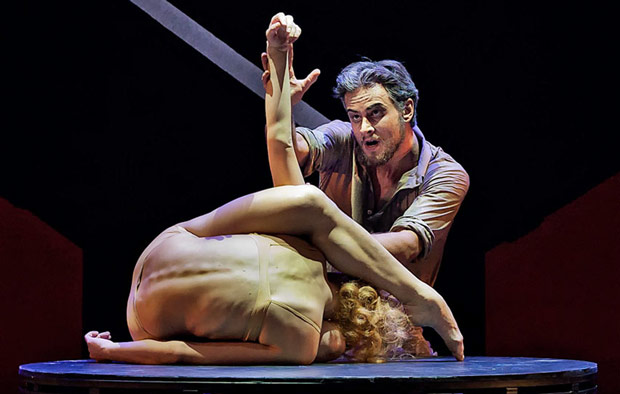
© Souheil Michael Khoury. (Click image for larger version)
Eifman Ballet
Rodin
Cannes, Palais des Festivals
29 November 2014
Interview with Boris Eifman (Feb 2014)
Gallery of pictures by Dave Morgan
eifmanballet.com
Heroines in ballet, drama and literature are so often victims, deceived or abandoned by their partners or lovers, neglected or mistreated by their families. Giselle, Violetta (in La Traviata) and Anna Karenina are all good examples. Camille Claudel was one such heroine-victim who during the 1880’s, as a young and very talented sculptress, became a student of the already well-known sculptor August Rodin. She soon became his muse, his lover and his assistant in his Paris studio. Their relationship, both creatively and personally, was passionate and tempestuous, in which Rodin would not leave the wife to whom he was still devoted and Claudel claimed that he was abusing her talent and even stealing her ideas. As Rodin became more and more successful she left him, had some success herself as an artist, but was showing signs of mental illness even to smashing her sculptures to pieces. Her brother, Paul Claudel, a well-known poet and diplomat, had her committed to a mental asylum, against the advice of doctors, where she lingered for the last 30 years of her life.
It is a story which lends itself to dramatisation and has inspired a film starring the French actress, Juliette Binoche. Boris Eifman had already created several ballets on similar themes, including his own versions of Giselle, Hamlet, Eugene Onegin and Anna Karenina, when he created Rodin in 2011. Eifman, who formed his first ballet company in St Petersburg in 1977, was considered a modern, even revolutionary figure in the very rigid world of Soviet dance. He was also one of the first to take advantage of the changes in Russia in the 1990’s to bring his company to the West and since then has toured in France, visiting Cannes regularly.
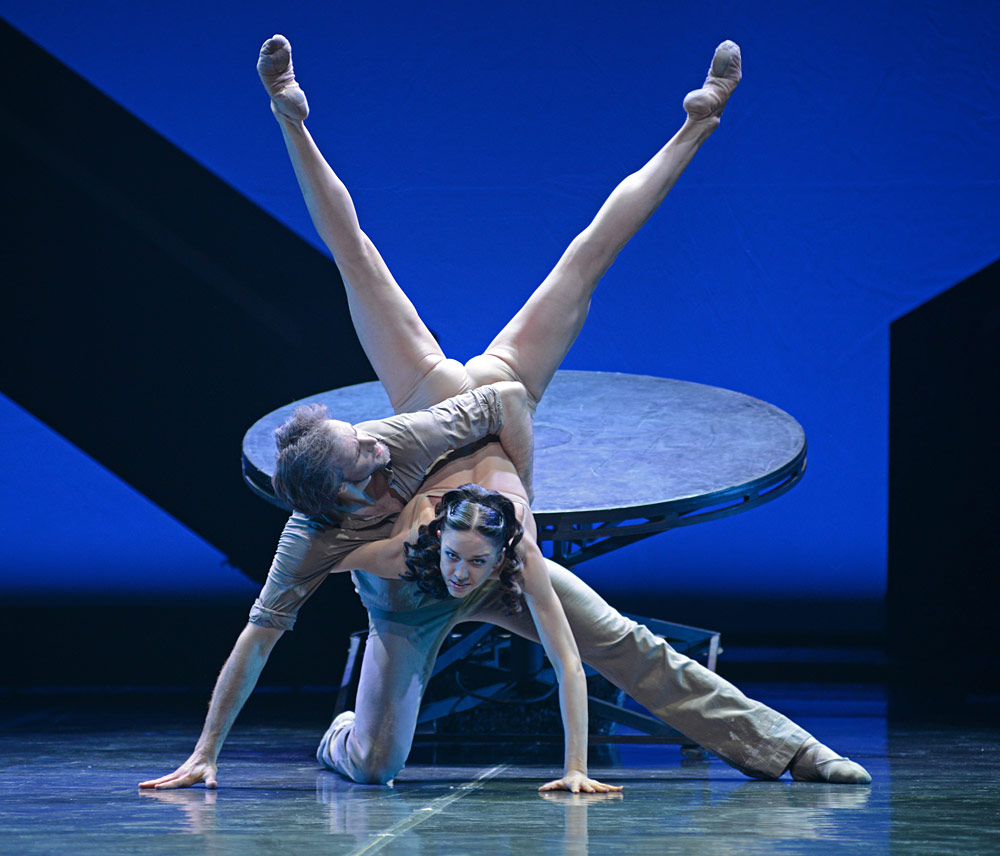
© Dave Morgan. (Click image for larger version)
The ballet Rodin is divided into a series of flashbacks, straightforward narrative and simple full-blooded dance scenes. In the opening scene, Claudel, (Lyubov Andreyeva), is found in a mental asylum as one of a group of white clad inmates. Rodin’s (Oleg Gabyshev) entrance is almost similar to Act 2 Giselle, and where the wilis taunt and frighten Albrecht, the females circle and chase Rodin, making a promising start to the ballet. However, this soon switches to a scene in his studio where he has an army of young male students who fill the stage with a lively dance, which incongruously looks very like a dance scene from an American musical but does show off the quality of the company’s male dancers. This is followed by Claudel’s first entrance into the studio and the first of many pas de deux’s, in which her extremely lithe and flexible body is manipulated, twisted, lifted and contorted into different shapes. Rodin has found his muse and the love affair has begun. There follows a number of scenes where repetition sets in: the mens’ almost naked bodies are piled up on each other and then moulded by Rodin and Claudel to form sensual, muscular sculptures, and these scenes are interspersed with ever more erotic pas de deux, filled with passion and anguish. Towards the end of the first act I thought I had lost the plot when a group of elegant women is satin evening gowns were joined by a gang of men dressed identically in green suits and clutching little red books, looking very like communist Maoists from another century. However, once Rodin appeared, now in a frock coat and top hat, it was clear that he had finally been recognised by the academics and members of society.

© Dave Morgan. (Click image for larger version)
Act 2 begins with an extremely lively Harvest Festival folk dance which is the excuse for a flash-back to Rodin’s first meeting with his wife, a simple country girl. This event gets lost in what is a simple divertissement, played straight out to the audience, but the ensuing duet is touching in its simplicity. Back to the narrative: Claudel now neglected, leaves Rodin and is left to live rough on the streets of Paris, where she has a passing amorous encounter. Apparently, Eifman felt the need to add another straight dance scene and the stage fills with dancers for a cancan. It is actually a good, if conventional, cancan, but has little to add to the unfolding drama, when Claudel is then discovered by Rodin and they are reconciled. The drama continues with more anguished pas de deux, some more violent scenes involving Rodin’s wife (Julia Manjeles), and a curious incident where Claudel wheels on a block of marble in wheelbarrow, which she manages to mount onto a plinth and starts hacking at, only to smash the final work to smithereens. Finally, she does end up in the asylum and these scenes I find positively unpleasant and tasteless. Eifman treats the inmates like playful retarded children, and there is none of the tragedy which Mats Ek brought to life in his version of Giselle, or Walter Gore in his highly dramatic Eaters of Darkness. Eifman is simply making fun out of mental illness.
Choreographically, the work suffers badly from repetition, although Eifman has a huge repertoire of imaginative movement, especially in the many duets. However, the over-use of splayed legs, wide open 2nd positions, on the floor, in the lifts, contorted, ugly movements becomes tedious. The company prove to be attractive and their commitment to the performance in scene after scene, admirable. All three soloists were excellent, and Oleg Gabyshev exceptional, almost a Jean Babilée quality with the same soft, springy jump and, as Rodin, he was the only one to become a believable character. Possibly the women were just kept too busy to develop theirs. Eifman is also hampered by his choice of music: this is a mishmash of half a dozen different composers, piano pieces and orchestral works, popular Parisian café music of the 19th century, and much of it rather hackneyed.

© Dave Morgan. (Click image for larger version)
Despite many critics’ reservations, Eifman’s work does remain popular internationally, and in France it can be explained by the lack of good quality touring dance in the country. The dozen or so major companies, based in cities such as Lyon, Bordeaux, Toulouse, give just 20 to 30 performances annually and rarely venture away from their home base. The many small contemporary groups throughout the country perform only sporadically and are totally dependent on the talent and experience of their choreographer-directors. For a town like Cannes a performance such as this offers excellent dancing, a superbly versatile and effective set, good lighting and attractive costumes and a story which may, or may not, be a bonus. For many it’s still a good night out.







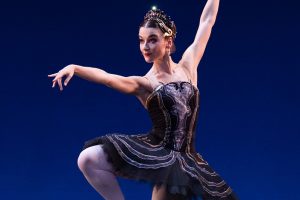


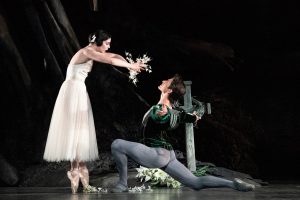
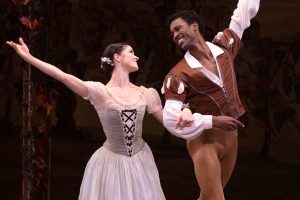
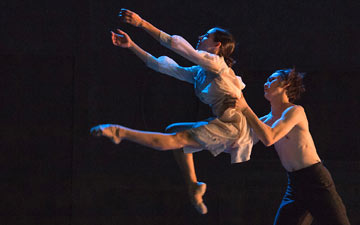
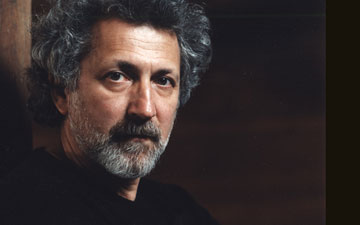
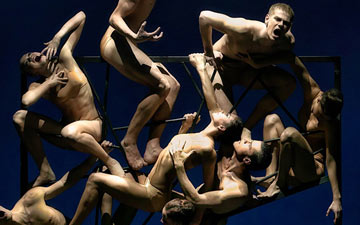
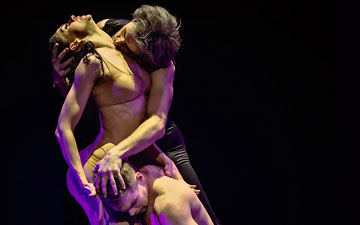
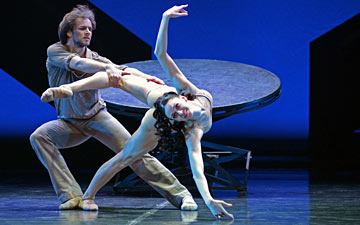
You must be logged in to post a comment.